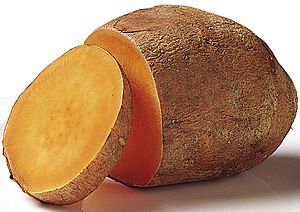Vegetable facts for kids
Vegetables are parts of plants that people eat. We usually eat them as part of a meal. This can include many different parts of a plant, like its flowers, fruits, stems, leaves, roots, and seeds.
Sometimes, the word 'vegetable' means all edible plant parts. But other times, it refers only to certain plants. For example, some foods like tomatoes or courgettes are botanically fruits because they have seeds. However, we often call them vegetables when we cook with them! Foods like nuts and grains are usually not called vegetables.
Carrots and potatoes are parts of a plant's root system. Since humans eat them, we call them vegetables. They are different from fruits, nuts, herbs, spices, or grains.
Vegetables are a very important part of a healthy diet. They are often grouped with fruits and called "produce". Vegetables give our bodies many good things. They have important vitamins like A, B, C, and D. They also provide minerals and carbohydrates, which give us energy.
Contents
Common Vegetables We Eat
Many different plants are enjoyed as vegetables around the world. Here are some common ones you might know:
You can find a much longer list of vegetables in the List of vegetables article.
Why Vegetables Are Good For You
Eating vegetables every day is super important for your health. They are packed with nutrients that help your body grow strong and stay healthy.
Vitamins and Minerals
Vegetables are like nature's multi-vitamins! They contain many different vitamins and minerals. For example, spinach and broccoli are full of Vitamin K and Vitamin C. Carrots are famous for Vitamin A, which is great for your eyesight. These nutrients help your body fight off sickness and keep all its systems working well.
Fiber for Digestion
Most vegetables are also high in fiber. Fiber is important for your digestion. It helps keep your stomach and intestines healthy. Eating enough fiber can also make you feel full, which can help you maintain a healthy weight.
Staying Hydrated
Many vegetables, like cucumbers and celery, have a lot of water in them. Eating these can help you stay hydrated, especially on hot days or when you are active.
How Vegetables Grow
Vegetables grow in many different ways. Some grow underground, like potatoes and carrots. Others grow above ground, like leafy greens such as spinach and lettuce.
From Seed to Harvest
Most vegetables start as tiny seeds. Farmers or gardeners plant these seeds in the soil. With sunlight, water, and good soil, the seeds sprout and grow into plants. Over time, the edible parts of the plant develop. Once they are ready, they are harvested, meaning they are picked or dug up.
Different Growing Climates
Vegetables can grow in many different climates around the world. Some prefer warm weather, while others do better in cooler temperatures. This is why you can find such a wide variety of vegetables available all year long.
Images for kids
-
Vegetables in a market in the Philippines
-
A home vegetable garden in London
-
This Venn diagram shows how "vegetables" (for cooking) and "fruits" (botanical) can overlap.
-
Southeast Asian-style stir-fried Ipomoea aquatica with chili and sambal
-
Vegetables in a supermarket in the United States
See also
 In Spanish: Verdura para niños
In Spanish: Verdura para niños













